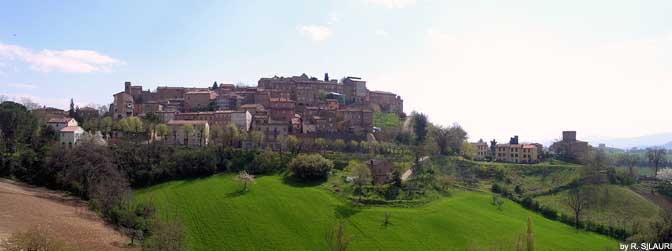Sant'Angelo in Pontano
Sant'Angelo in Pontano website - Conoscere un paese ...
|
Welcome to Sant'Angelo in Pontano
venerdì, giugno 19, 2020, 11:00 PM - Turismo
Sant'Angelo is a typical, ordinary place of the "Bella Italia" widely appreciated in the world. A place where everyone knows each other, with pros and cons of the inner Marches' provincial life. Being part of the Blue Mountains - Monti Azzurri Community, In the Macerata province, on an ancient road to Piceno, not far from the Adriatic Sea and the Sibillini mountains, Sant'Angelo is a cozy village set in the heart of the Marches, built up slowly across the ages by many people that have passed through or lived here leaving signs of their culture. With well visible and preserved civil and religious architecture, art is the witness of the history of these places. The Benedectine abbey and a number of churches, are caskets that preserve nice canvas and other artworks. They show us how this land was a place of sincere cultural and artistic activity, where craftsmen, hard labour and faith in God have deeply affected the landscape. Sant'Angelo offers a number of panoramic view over the adjacent valleys of the rivers Ete Morto and Tenna, with an unlimited extension of hills that, in harmonic sequence, slope down from the Apennines' chain of mountains to the sea, embracing the countryside in their splendid nature of agricultural environment. You can step back in time and enjoy the patchwork landscape of neatly ploughed fields, sunflowers vineyards, oak and olive trees, scattered farmhouses, and hilltop towns and villages with views stretching up to the mountains and down to the Adriatic sea.  Population: 1512 Sant’Angelo in Pontano stands at a height of 473 metres above sea level The nameThe first part of the name is clearly a reference to st. Michael the Archangel, a saint very dear to the Lombards, whose image appears on the town coat of arms; according to recent tradition, the second part derives from pantano meaning “swamp” or “marsh”; it seems that in early times there was an area of marshland in the valley below the settlement. However, the name comes from the location of Sant’Angelo in the administrative district of gastaldato Pontano established by the Lombards' Duke of Spoleto. La collegiata and other monuments Worth visiting is the beautiful Romanesque church of S.Salvatore built in the XII century, with its crypt and presbytery. It has a beautiful fresco of Madonna and Child (Salimbeni school XIV-XV century). Worth visiting is the beautiful Romanesque church of S.Salvatore built in the XII century, with its crypt and presbytery. It has a beautiful fresco of Madonna and Child (Salimbeni school XIV-XV century).Other main historic buildings are: - Church of San Michele, built over a former Lombard chapel of which a basrelief remains today. - San Nicola church (late 15th to 18th century), dedicated to the patron saint. Remarkable frescos and paintings (Cappellone by Domenico Malpiedi) - Santa Maria delle Rose church - Rocca (castle) of San Filippo (13th century), outside the town. - Watchtower (known from 1397) - Municipal Theater "N.A. Angeletti" (19th century) Sant'Angelo offers 3 remarkable restaurants, bar, pizza shops, farmhouses, country houses, and all your day to day needs. Paths and tracksThere are many rural and summer holiday places scattered with country houses, preserving a millennial tradition. Mountain bikes is an excellent way of exploring the local countryside, and from the village you can explore a number of natural historical and scenic paths connecting Sant’Angelo to the nearby villages of Penna San Giovanni and Gualdo. The tracks wind through predominantly oak woods and are easy to follow, on foot or by bicycle, with many little streams running through this lovely landscape.   Interactive map by Google Maps Interactive map by Google MapsSant'Angelo - San Ginesio - 12km Sant'Angelo - Macerata - 28km - International Airport Ancona Falconara (100 km) Flights in Real time - Motorway E55/A14 Milano-Bari (exit Civitanova-Macerata) - Highway Civitanova-Foligno - State road 77 – State road 78 - Railway Fabriano-Civitanova CharactersSaint Nicholas of Tolentino was born in the village of Sant'Angelo in Pontano in 1245. Nicola Antonio Angeletti (S. Angelo 1791 - S. Angelo 1870) Protagonist and patriot of the Italian Risorgimento. He actively participated in the Napoleonic war campaigns, in the attempt to invade the Papal States in 1921, in the Carbonari uprisings, in the defense of Rome in 1949 and in the Garibaldi campaign in Sicily, passing through the vicissitudes of war, exile, torture and hard prison. The main square of the town and the Municipal Theater are named after him On Tuesday 5 January 2010, in the community of Milan, has returned to the Father Fr. Leonardo "Francesco" Zega, 81 years, 68 of Pauline life, 55 of priesthood. Born in S. Angelo in Pontano (Macerata, Italy) on 19 April 1928, he entered as a thirteen-year old in the Roman seminary of the Society of Saint Paul on 9 October 1941. Immediately from the start he showed a marked inclination for the priestly religious life; and not delaying to emerge were his frank and determined sometimes easygoing character, his lively intelligence, many-sided entrepreneurship, ease in writing and talking: qualities that he put to fruition in his apostolate in the field of Pauline journalism. He entered the novitiate in Alba (Cuneo) in September of 1944 and made his first religious profession on 8 September 1945, taking the name of Francesco in that circumstance. | permalink
|
     ( 3 / 2730 ) ( 3 / 2730 )
Indietro Altre notizie |
 English
English




